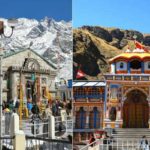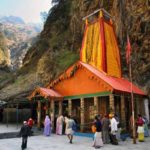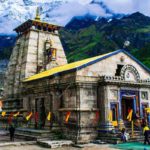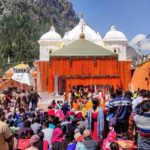Badrinath Temple is a Hindu temple dedicated to Lord Vishnu, located in the town of Badrinath in the state of Uttarakhand, India. It is one of the Char Dham pilgrimage sites and is considered one of the holiest temples in Hinduism. The temple is situated at an elevation of 3,133 meters (10,279 feet) in the Garhwal Himalayas, nestled between the Nar and Narayana mountain ranges.
The Badrinath Temple is a significant pilgrimage destination for Hindus, particularly Vaishnavites, who worship Lord Vishnu in the form of Badrinath, the preserver and one of the major deities of Hinduism. The temple is part of the Chota Char Dham Yatra, which also includes the pilgrimage sites of Yamunotri, Gangotri, and Kedarnath.
The temple is believed to have been established by the Adi Shankaracharya, a renowned Hindu philosopher and theologian, in the 8th century. It underwent several renovations and reconstructions over the centuries and is now a major architectural and spiritual landmark in the region.
The Badrinath Temple is constructed in the traditional North Indian style of temple architecture, with a distinctive dark stone facade and a towering shikhara (spire) adorned with a gold-toned umbrella. The sanctum sanctorum houses the idol of Lord Badrinath, which is believed to be a 1-meter tall black stone statue in a meditative posture.
The temple attracts thousands of devotees and tourists from all over the world, especially during the pilgrimage season from April to November. It is known for its serene and picturesque surroundings, including the nearby Alaknanda River and snow-capped Himalayan peaks. The temple also has various rituals, festivals, and traditions associated with it, including the Badri-Kedar festival, which is celebrated during the months of June and July Char Dham Tour Packages.
The Badrinath Temple holds immense religious and cultural significance for Hindus and is considered a sacred pilgrimage site that symbolizes purity, spirituality, and devotion. It is a revered destination for seeking blessings, performing religious rites, and experiencing the divine aura of Lord Badrinath in the lap of the majestic Himalayas.
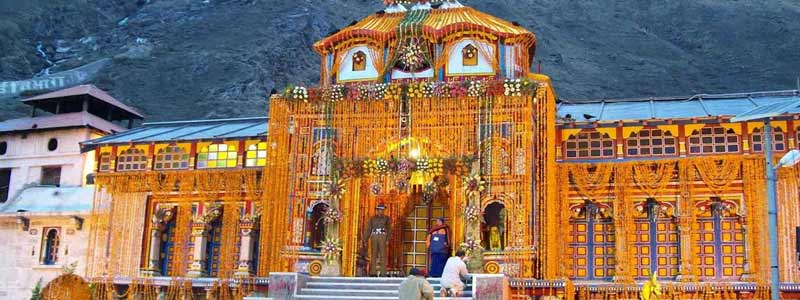
Places to Visit in Badrinath
Badrinath, located in the state of Uttarakhand, India, is not only known for its famous Badrinath Temple but also offers several other tourist places to explore. Some of the popular tourist places to visit in and around Badrinath are:
- Mana Village: Mana Village is the last inhabited village on the Indian side of the Indo-China border and is located just 3 km away from Badrinath. It is known for its scenic beauty, traditional houses, and cultural significance. Visitors can witness the Vyas Gufa (cave) where it is believed that sage Veda Vyasa wrote the Hindu epic Mahabharata, and the Ganesh Gufa, where Lord Ganesha is said to have written the epic as dictated by Vyasa.
2. Vasudhara Falls: Located about 9 km from Badrinath, Vasudhara Falls is a stunning waterfall nestled amidst lush green mountains. It is believed that taking a dip in the icy cold waters of Vasudhara Falls can wash away one’s sins according to Hindu mythology. The waterfall is surrounded by scenic beauty and offers a serene and peaceful atmosphere.
3. Tapt Kund: Tapt Kund is a natural hot water spring located just below the Badrinath Temple. It is believed that taking a dip in the holy waters of Tapt Kund before visiting the temple is considered auspicious and purifying. The water is said to have medicinal properties and is believed to cure various ailments, Char Dham Travel Guide.
4. Charan Paduka: Charan Paduka is a sacred rock located about 3 km from Badrinath, which is believed to bear the footprints of Lord Vishnu. It is a popular pilgrimage site and offers panoramic views of the surrounding mountains and valleys. According to Hindu mythology, it is believed that Lord Vishnu stayed at this spot before proceeding to Vaikunth, his heavenly abode.
5. Neelkanth Peak: Neelkanth Peak is a majestic snow-capped peak located near Badrinath, named after Lord Shiva, whose throat turned blue (Neelkanth) after consuming the poison that emerged during the churning of the cosmic ocean. It is a popular trekking destination and offers breathtaking views of the Himalayas.
6. Hemkund Sahib: Hemkund Sahib is a Sikh pilgrimage site located about 45 km from Badrinath Temple. It is a glacial lake situated at an altitude of 4,632 meters and is considered one of the highest Gurudwaras in the world. The Gurudwara is dedicated to Guru Gobind Singh, the tenth Guru of the Sikhs, and is known for its scenic beauty and spiritual significance.
7. Valley of Flowers National Park: The Valley of Flowers National Park is a UNESCO World Heritage Site located about 38 km from Badrinath. It is famous for its meadows of alpine flowers, rare and endangered plant species, and stunning landscapes. It is a popular destination for trekking and offers breathtaking views of the Himalayas.
These are just a few of the many tourist places to visit in and around Badrinath. The region is known for its natural beauty, religious significance, and cultural heritage, making it a popular destination for pilgrims and tourists alike.
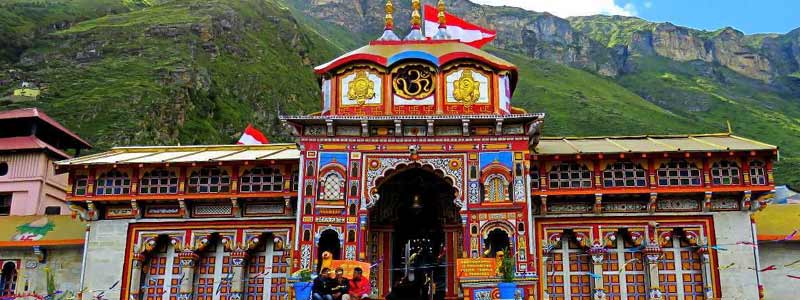
Best Time to Visit Badrinath
The best time to visit Badrinath depends on the preferences and requirements of the visitors. Badrinath is a high-altitude pilgrimage site located in the Garhwal Himalayas of Uttarakhand, India, and the weather conditions can vary greatly throughout the year. The recommended time to visit Badrinath is during the summer and early autumn months, when the weather is pleasant and conducive for travel and pilgrimage. The following are the different seasons and their characteristics in Badrinath:
Summer Season (May to June): This is considered the best time to visit Badrinath as the weather during these months is mild and pleasant, with temperatures ranging from 10 to 25 degrees Celsius. The snow starts melting, and the roads leading to Badrinath are usually accessible. The temple is open for darshan (worship) during this time, and pilgrims can comfortably visit and pay their respects.
Monsoon Season (July to September): The monsoon season in Badrinath is characterized by heavy rainfall, which can lead to landslides and road closures, making it challenging to travel to and from Badrinath Temple. The region receives moderate to heavy rainfall during these months, and the temple may remain closed during extreme weather conditions. It is advisable to check weather conditions and road accessibility before planning a visit during the monsoon season.
Autumn Season (September to November): The autumn season is another favorable time to visit Badrinath, especially during September and October. The weather starts getting cooler, with temperatures ranging from 5 to 20 degrees Celsius. The monsoon recedes, and the region is lush green after the rains, offering picturesque landscapes. The temple is usually open until late October or early November, depending on weather conditions.
Winter Season (November to April): Winter in Badrinath is extremely cold, with heavy snowfall and temperatures dropping below freezing, ranging from -5 to 10 degrees Celsius. The region receives heavy snowfall, and the temple remains closed during the winter months due to extreme weather conditions. The region is also prone to road closures and limited accessibility during winters, making it challenging for travel.
In conclusion, the best time to visit Badrinath is during the summer and early autumn months of May to June and September to November when the weather is pleasant, and the temple is open for darshan. It is advisable to check weather conditions, road accessibility, and the temple’s opening status before planning a visit to Badrinath Temple to ensure a safe and hassle-free pilgrimage.
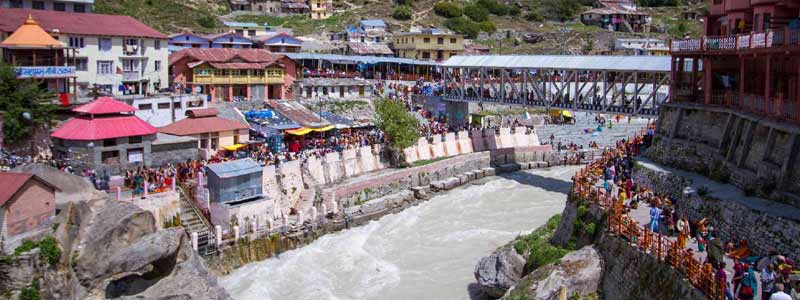
How to Reach Badrinath
Badrinath, located in the state of Uttarakhand, India, is well-connected by road and air. The nearest airport and railway station to Badrinath are in Dehradun, which is approximately 318 kilometers away. From Dehradun, one can hire a taxi or take a bus to reach Badrinath. Here are the various ways to reach Badrinath Temple:
By Road: Badrinath is well-connected by road to major cities in Uttarakhand and neighboring states. Regular bus services operate from Rishikesh, Haridwar, Dehradun, and other nearby towns to Badrinath. One can also hire a taxi or take a self-drive car to reach Badrinath. The road to Badrinath is scenic but can be challenging, especially during monsoons and winters when there may be road closures due to landslides or snowfall. It is advisable to check the road conditions before planning a trip and drive carefully.
By Air: The nearest airport to Badrinath is the Jolly Grant Airport in Dehradun, which is approximately 318 kilometers away. From the airport, one can hire a taxi or take a bus to reach Badrinath. The airport is well-connected to major cities in India like Delhi, Mumbai, and Kolkata, with regular flights operated by various airlines.
By Train: The nearest railway station to Badrinath is the Rishikesh Railway Station, which is approximately 295 kilometers away. From Rishikesh, one can hire a taxi or take a bus to reach Badrinath Temple. Rishikesh is well-connected to major cities in India by train, and there are regular trains operated by Indian Railways and other private operators.
It is important to note that Badrinath Temple is located at a high altitude, and the weather conditions can change quickly. It is advisable to check the weather conditions, road accessibility, and the temple’s opening status before planning a visit to Badrinath, especially during monsoons and winters. It is also recommended to carry warm clothing, essential medications, and travel with a local guide or experienced driver if visiting for the first time to ensure a safe and comfortable journey.



